You know it’s not often that I double-post places – it means I really like them. I really like Fukahama. When readers Kwong and Hachi came to town (and this was not a short trip by any means) and suggested we meet, I quickly thought of Fukahama as a place that does really well at mixing kaiseki forms and elegance with an approachable feel and affordable pricing. I defy anyone to look at the pictures and think this isn’t a place worth trying. As you go, see what you think the price should be…
Well, it was raining outside, and for some reason the gloom carries over a little to this picture despite the brightness and warmth. The room is almost unnaturally clean, with light wood, carpeted and cushioned booths, and a normal counter backed by a few art pieces and rows of glasses, some of them in the Edo-kiriko carved style. You can also see Fukahama playing their hand right away with the cherry blossom-themed place mats; the menu is about as seasonal as one can get.
The first time I went, there were three other people. That was the most I’ve ever seen, although I suppose this time with 3 in our party and these two guys should count as the record. Sometimes there’s a private event in their upstairs entertaining room, but it’s unclear to me how they stay in business. Still, they’ve been here as long as I have, and that’s quite long enough to establish a successful track record. Mom is behind the counter (I like to think that she’s the chef’s mother, but I’ve never asked), and she adds a lot to the proceedings with her warm but deeply awkward attempts to be polite. She has a hard time believing that I’m speaking Japanese, which led her on this occasion to turn frequently to the two Asian members of the party for confirmation…which didn’t help a whole lot, them being Malaysian and all.
There it is, right there. The ingredients change seasonally, but the effect is the same. This is one of the most creative, prettiest zensai plates I’ve seen anywhere. Since I correctly guessed most of them, I’ll run down the list for you…starting upper left with the mozuku and going clockwise, there’s a tranche of nikogori jelly with blowfish skin, a low-temperature egg yolk infused with sugar and dashi and wrapped in poached brussels sprout leaves, three firefly squid with vinegar miso sauce, dumplings made from lima beans and lily bulbs, a round piece of sushi of lightly-pickled snapper, and a little ocean snail (boiled). Not pictured is the boiled spinach; not expressible is how good it all was!
This artistic shot gets the dumplings up front, the sushi center-left, the fish jelly under the cherry blossoms, and the egg yolk squeezing out of the frame at the back.
I should mention, all of this is described in loving detail on a very pretty menu that carries over the seasonal themes with a few graphics.
Dark and forboding…no, not really, just clear soup in a black bowl. The clear soup is usually the second high point of meals at Fukahama for me. Somehow, the way the chef gets his dashi is exemplary. How often do you drink clear broth and just say ‘Wow’? I have often gotten that feeling here. Not so much tonight, but it was no loss – the broth was overshadowed by the other ingredients. In front is some nanohana, no surprised, and a shiitake. The little ‘leaf’ at 12 o’clock is a carved slice of lily bulb (same as the white dumpling in the appetizer plate). The real surprise was under that – a piece of spring Ayu, the fish that you commonly see impaled on skewers and roasting around fires, wrapped in a pickled cherry leaf. The whole soup took on the characteristic flavor of the leaf (like sakura mochi, if that helps you). The menu described this as ‘sakura ayu’ (it seemed a little bigger than your average ayu), and it was prepared in the most interesting fashion – imagine cutting a square chunk out of a normal filet, then repeatedly slicing it vertically, very fine, just down to the skin, and simmering the result. The result was sort of like a ‘book’, or leaves of fish, that fanned apart when you touched them. A little like hamo preparation, if that helps you, but somehow much more elegant.
I have, in the past, been disappointed by the sashimi course at Fukahama. I was very, very happy with this. The prawn was exemplary (and, I’m happy to say, a first for Kwong and Hachi, who pronounced it ‘creamy’), and the other fish (I’m guessing kanpachi and hirame on the left and right, with squares of engawa on top of the hirame, and in back two pieces of chutoro cheekily hiding another piece of akami) were also very good. Really a surprise, since I had been nervous about this.
Just in time to explain it, I remembered how to pronounce 鰆 from the menu. All this study of fish kanji is really paying off, let me tell you! Soon I’ll be able to make a living from reading fish kanji! Sawara is usually just written in hiragana on menus, and it’s usually grilled after being lightly preserved in sweet miso. This was different, and a nice change, because it was done in an unusual (for me) style, yuzuan yaki – kinda like the fish was glazed with yuzu flavor before grilling. Also not grilled to the point of dryness, which is a problem with cooked fish in kaiseki. The oyster was (pre-)cooked and glazed as well, but not too memorable, partly on accounta it’s coldness.
Now that I think about it, I can’t help wondering if they gave us some upgrades from the basic course as a bonus for being a repeat customers (Mom was pretty excited when I called). This all seems quite nice…
I don’t remember these bowls from before. While I was disappointed not to get anything with makie-style painted pictures and gold dust, this was neat. I wasn’t all that tempted to buy a set for the house though!
Here, a freakin’ symphony of spring vegetables! And a carrot. And some fish eggs. Yeah, the bamboo shoot in back was excellent, the simmered turnip under it (not potato as I thought; Kwong picked that one correctly on sight!) also good, and the fish eggs much nicer than the last time I had them (Ranman).
Are you starting to wonder when this all stops? I mean, if you know the sequence of dishes then you won’t be wondering at all, but if not, this is looking pretty fancy, no?
Fried things on the night included a taranome (front) and some type of long, thin pepper (a shishitou by any other name, but too long). The bits fairly hidden in the back are white fish wrapped around bamboo shoot (right) and I swear a piece of lobster also stuffed with bamboo. It’s hard to believe there was lobster in this set, but the redness of the pink bits in the meat, as well as the size, looked a lot more like lobster tail than botan or kuruma ebi.
For shokujis, nothing so banal as rice…this is Inaniwa udon, a relative rarity. They’re light, thin, flat, white udon, and these must have been fresh judging by the chewiness. A little soft, perhaps, but a good noodle. I hope people say that about me when I’m gone.
Arrrrgh, and this reminds me that I forgot to upload my clever picture of Inaniwa Castle to fit in here. Seriously, I’ve actually been to Inaniwa, from where this type of noodle hails. The town is nothing to look at. In fact there isn’t even a town there. And I see now that I’ve already used the clever picture in a post about noodles I ate in the Shonai area, so get thee hence and content thyself with it,
while I eat some fruit. So simple, so humble, so sweet. If these strawberries weren’t glazed with sugar, they were the sweetest damn strawberries I’ve ever eaten. I think they were glazed. The melon was good too, seasonality be damned.
Y5000. OK? Y5000.
03-3641-5987
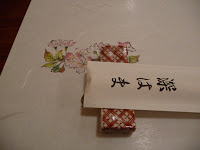
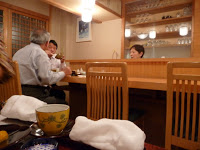
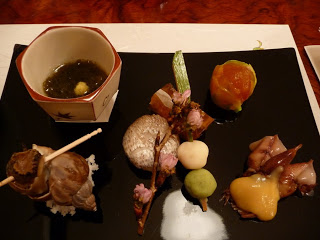

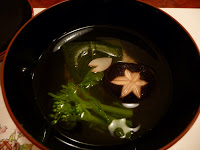
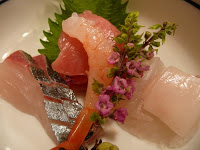
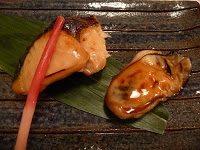
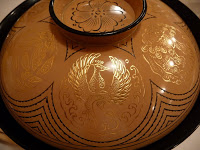
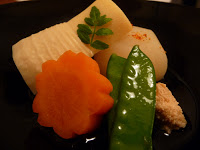
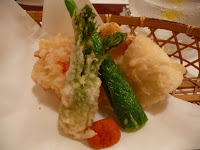
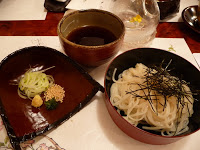
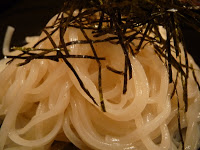
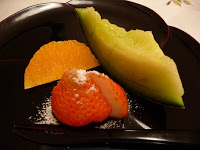
Looks great and cheap for 5000 yen.